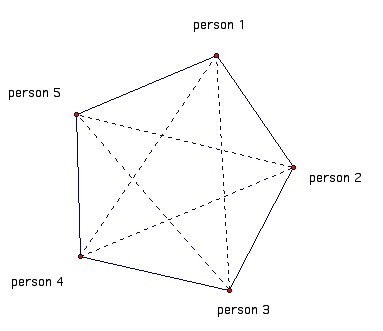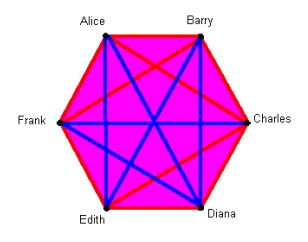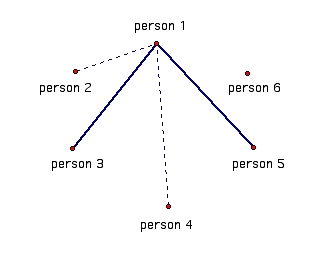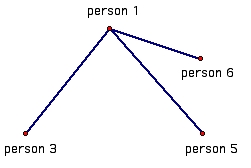
You're one of six people at a dinner party. You look across the table at your five companions. You would undoubtedly find that the dinner party includes either a group of at least three people who all know one another or a group of at least three people who don't know one another. The reason for this certainty lies in a mathematical proof that any gathering of six people will always automatically include one or the other of these two groupings.
| No such guarantee is possible when five or fewer people are present. Let a dashed line connecting 2 people mean that they have not met before and let a solid line connecting 2 people mean that they know each other already. Then, a group of three people who all know each other will be represented by a solid triangle connecting the three, while a group of three people who have never met before will be represented by a dashed triangle connecting the three. The following picture is an example of a five-person party in which we cannot find such a group of three people because we cannot find any completely dashed or solid triangles connecting the three people. |

|
| Here is an example of a six-person party, where red represents people who have never met before while blue represents people who already know each other. Notice that in this six person party, Charles, Diana, and Edith are an example of a group of three people who have never met before since they connect to each other via a red triangle. |

|

| Instead, we reduce the problem to looking at just 4 of the 6 people as follows. Given any 6 person party, we check to see who person 1 has met before. There are 5 people to check and so there must be 3 people that are connected to person 1 by the same type of line (dashed or solid). For example, in the following picture, if person 1 knows person 6 (solid line) then person 1 knows person 3, 5 and 6 (3 people). If instead, person 1 has never met person 6 (dashed line) then person 1 has never met person 2, 4 and 6 (3 people). No matter what group of people, there must be at least 3 who person 1 is connected to by the same type of line. |

|
 Notice that I have listed all of the possibilities and in everyone of
them I can find a triangle of the same color.
Notice that I have listed all of the possibilities and in everyone of
them I can find a triangle of the same color.
The result represents a special case stemming from a branch of mathematics known as Ramsey theory. Instead of talking about six people, you could consider groups consisting of any number of people. Instead of specifying just two relationships (acquaintances and strangers), you could have any number of mutually exclusive relations. For example, you could consider people (or nations) who are allies, foes, and neutral parties--representing three mutually exclusive relationships--embroiled in a widespread conflict. In general, Ramsey theory concerns the existence of highly regular patterns in sufficiently large sets of randomly selected objects, whether they are gatherings of people, sequences of randomly generated numbers, randomly placed points in the plane, or even stars in the night sky.
Some parts are taken from Ivars Peterson's Party Games